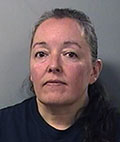
The police surveillance video of Central Avenue, Batavia, the night of May 17, when Nathaniel D. Wilson Jr., murdered Terry J. Toote with a knife, shows that Wilson was a threat to harm other people in the area, according to an attorney for Jennifer K. Urvizu-Hanlon.
Urvizu-Hanlon, former owner of La Mexicana store on East Main Street, is charged with criminal liability for conduct of another/criminal possession of a weapon, 2nd. She is accused of giving a handgun, which she was permitted to carry, to Samuel R. Blackshear, a 17-year-old who is accused of shooting Wilson.
"This individual was trying to keep the other individual from stabbing other people, which I believe is legally justifiable," said attorney Christian Kennedy.
Today's County Court appearance for Urvizu-Hanlon was a hearing related to motions filed by both the defense and the prosecution with arguments for further hearings in the case.
Kennedy revealed his theory of the case while arguing that the prosecution needs to turn over to him a list of witnesses along with any statements they made to police and reports generated from witness statements.
Under the rules of evidence, the defense isn't automatically entitled to this material. There are rules regarding "discovery," or evidence the people must turn over, and then what is known as "Brady material" (the name comes from a precedent-setting case dealing with evidence). Brady materials are statements and reports that the defense believes may contain information that would support a defendant's claim of innocence.
Kennedy argued that given the number of witnesses, the statements he believes the police collected (there's no information available to indicate such statements were obtained) would almost certainly contain contradictory views of events, which then would almost certainly be Brady material. And if all the statements agree, he said, that might indicate the police relied on a single witness statement, which under the circumstances, could be used by the defense to demonstrate a problem with the investigation.
Either way, Kennedy argued, it's Brady material.
Judge Charles Zambito pressed him for more definitive information that would indicate Kennedy knew there was information in the material favorable to his client, and Kennedy said he couldn't know that without seeing the material but that in Monroe County the material is always provided to the defense for the reasons he outlined.
Zambito said he would review the material to determine if it contains information favorable to the defense and turn it over if necessary.
During the discussion in court today, it was suggested that Urvizu-Hanlon had said to Kennedy that she gave the gun to Blackshear to protect others. Kennedy corrected the statement, saying that he hadn't indicated one way or the other what his client may have said to him. He was stating, he said, that the video itself indicated Wilson was threatening others at the scene.
He said while the video clearly shows events on Central Avenue that night, it is too grainy to help the defense identify witnesses.
Blackshear is charged with: attempted murder, 2nd; attempted assault, 1st; assault, 2nd; and two counts of criminal possession of a weapon, 2nd.
Urvizu-Hanlon, 48, apparently made statements to police after being read her Miranda warnings. A hearing on whether the proper procedures were followed by police will be held at 3 p.m., Oct. 19.
He's also seeking a probable cause hearing, arguing his client was arrested May 18 without a warrant, so he wants to probe whether police had at that point probable cause to take her into custody. Zambito is reviewing that request.
The 31-year-old Wilson entered a guilty plea to murder in the second degree Aug 20.
At his plea hearing, District Attorney Lawerence Friedman cited witness statements indicating Wilson approached the scene making statements that indicated he intended to "kill everybody." He then attacked Toote.
Several people then jumped on Wilson and Wilson continued to fight with them.
Wilson entered his guilty plea on an Alford basis, which means he didn't admit to facts of the case, only that he would likely be found guilty if the case went to trial, so he was, therefore, accepting a plea deal more favorable than what he might receive if found guilty by a jury.
He faces a possible prison term of 20 years to life.
